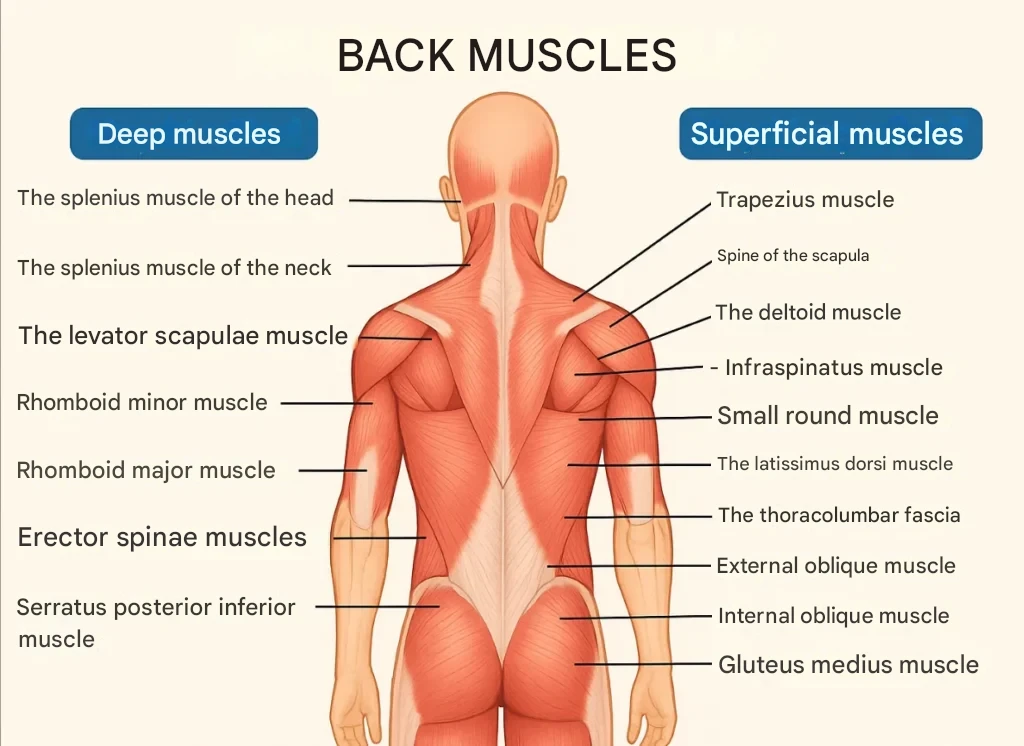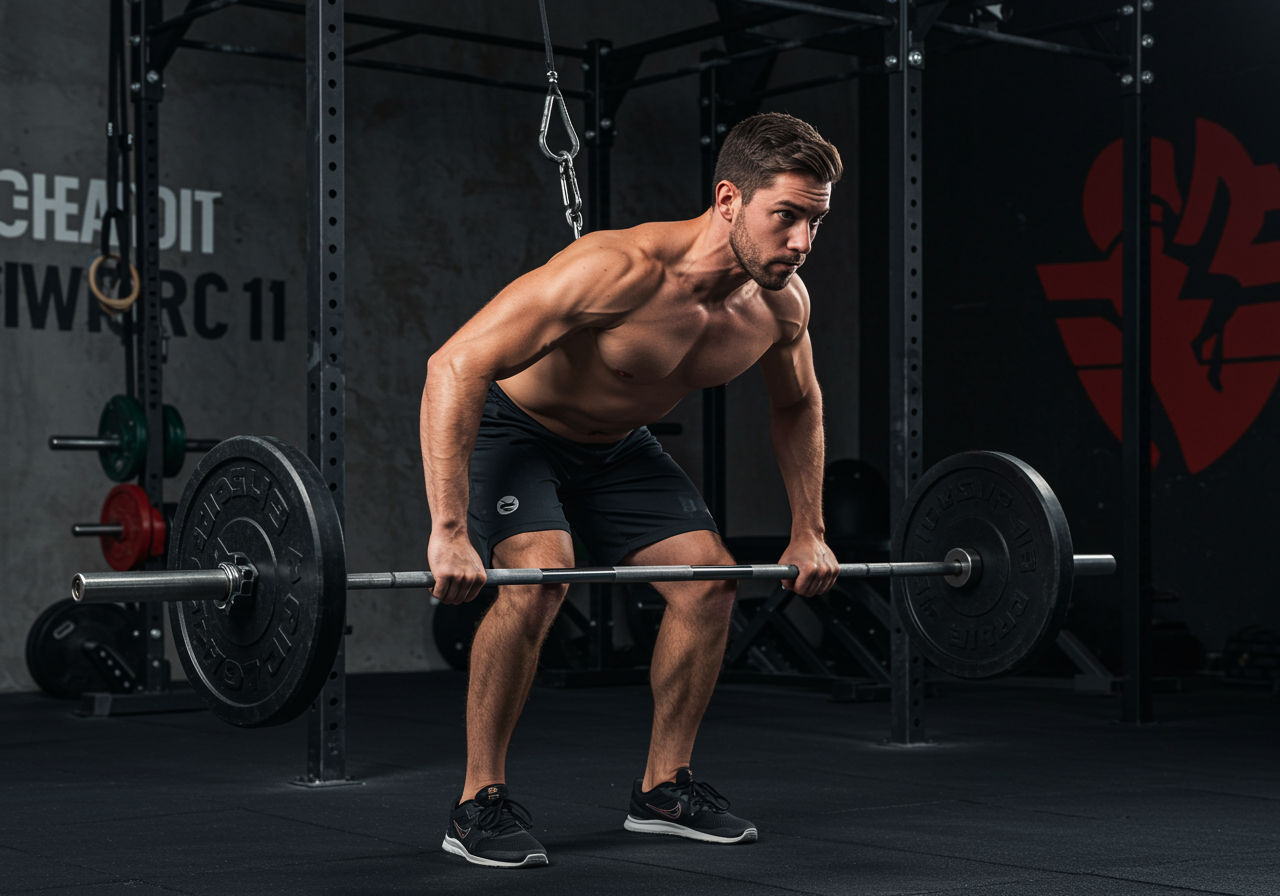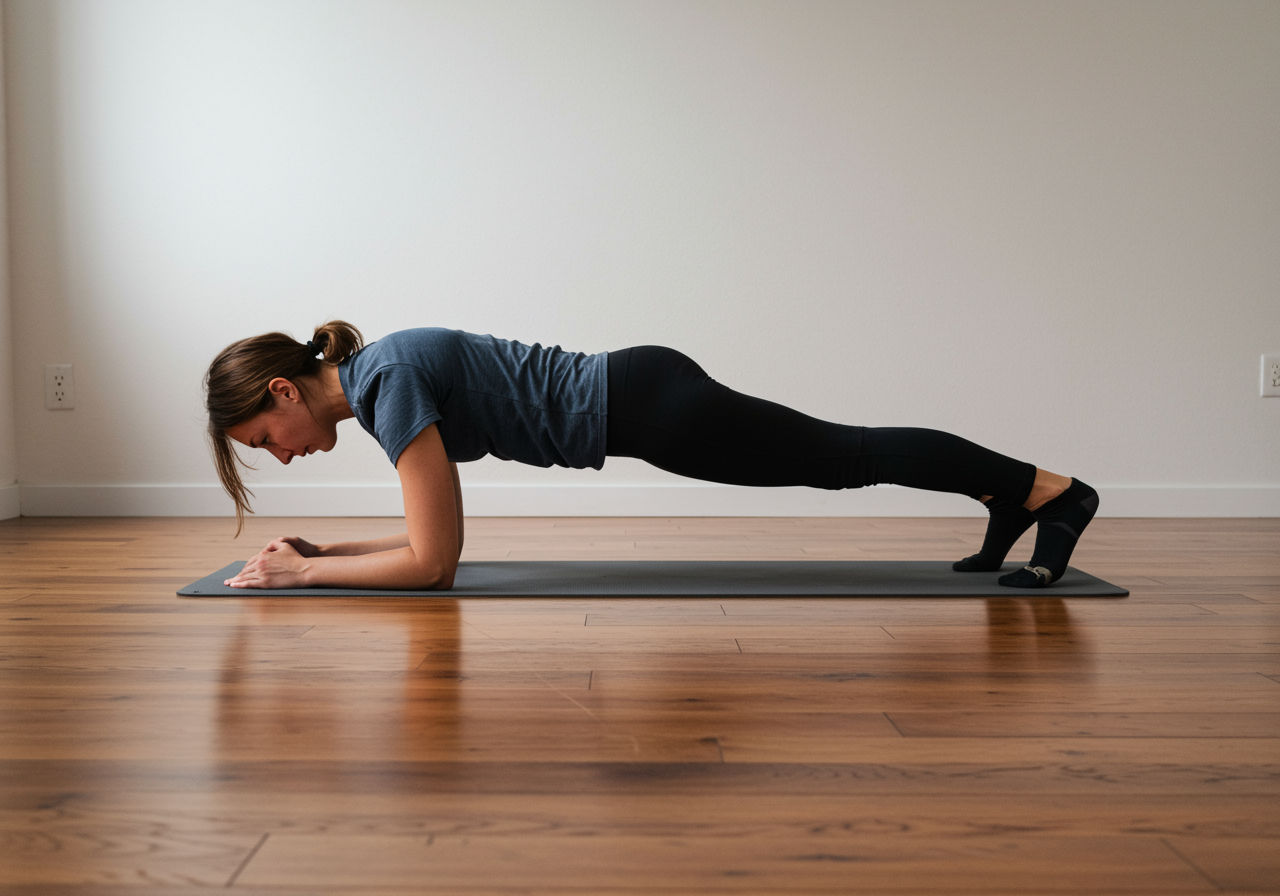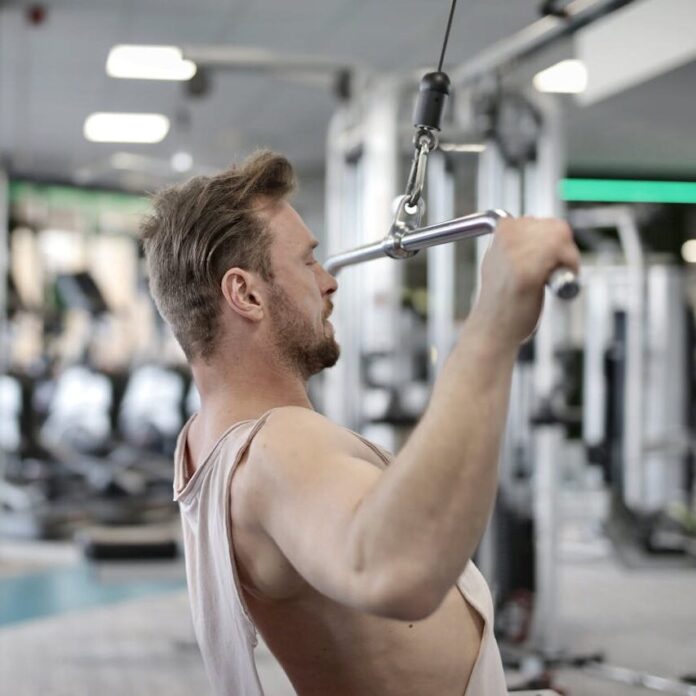Back pain affects a significant percentage of the population, negatively impacting quality of life and productivity.
A well-structured exercise program, tailored to individual fitness level and goals, can significantly contribute to pain relief, improved posture, and increased muscle strength.
This guide details the most effective back exercises, both for gym and home workouts, providing essential information on correct execution technique, targeted muscle groups, and training programs adapted to each experience level.
The importance of back exercises in fitness
Back exercises are an essential component of any complete fitness program. They bring numerous benefits to both health and physical appearance. An effective back workout improves posture, reduces the risk of back pain, increases strength and muscle mass, contributes to a harmonious and balanced physical appearance, increases spinal stability and helps prevent injuries during other physical activities.

For optimal results, a back workout should include exercises that target the major muscle groups of the back: the latissimus dorsi, trapezius, rhomboids, and erector spinae. Some of the most effective back exercises include pull-ups, barbell rows, deadlifts, back extensions, and single-arm dumbbell rows.
It is recommended to perform 2-3 back workouts per week, with 3-4 exercises per session and 3-4 sets for each exercise. The number of repetitions can vary between 8-12 for muscle growth or 12-15 for toning, depending on the individual goals and level of experience of each person.
Back anatomy and targeted muscle groups
To maximize the effectiveness of your workouts and reduce the risk of injury, it is crucial to understand the anatomy of the back and the role of each muscle group. The back is made up of several important muscle groups that work together to provide stability and mobility to the torso. The main muscles of the back are:
- Latissimus dorsi – the largest and strongest muscle of the back, responsible for adduction, extension and internal rotation movements of the arm
- Trapezius – triangular muscle covering the upper back and neck, involved in movements of the scapula and head
- Rhomboids – muscles located between the shoulder blades, which retract the scapula
- Erector spinae – group of muscles that run along the spine and are responsible for trunk extension
- Rotator cuff muscles – small muscles located between the vertebrae that stabilize the spine

For an effective back workout, it’s important to include back muscle exercises that target all of these major muscle groups. Some of the most effective exercises are:
- Pull-ups – works the latissimus dorsi, lower trapezius and biceps
- Dumbbell Row – involves the latissimus dorsi, trapezius, rhomboids and erector spinae
- Deadlifts – work the erector spinae, latissimus dorsi, and gluteal muscles
- Back Extensions – isolates the spinal erectors
- Face pulls – target the trapezius and rhomboids
A balanced training program should include exercises that work all of these muscle groups to develop a strong, defined, and functional back.
The most effective back exercises at the gym
To build a strong and defined back, the gym offers a variety of options and specialized equipment. An effective back workout at the gym should include a combination of compound and isolation exercises that target the major muscle groups of the back. Here are some of the most effective back exercises at the gym:
1. Pull-ups
Pull-ups are a great compound exercise that works the latissimus dorsi, lower trapezius, and biceps. They can be performed with a wide, medium, or narrow grip to gently target different areas of the back.

2. Barbell row
This back exercise involves the latissimus dorsi, trapezius, rhomboids, and erector spinae. It is performed from a bent position, pulling the bar towards the abdomen.
3. Seated cable row
It offers a fluid and consistent movement, making it ideal for working the lats and teres major. It allows for a full range of motion safely.
4. Deadlifts
Although considered a leg exercise, push-ups also work the spinal erectors intensively, contributing to the development of the lower back. To vary your leg workout, you can also include specific leg exercises , thus ensuring harmonious development of the entire body.
5. Bench back extensions
This exercise isolates the spinal erectors and helps strengthen the lower back, which is beneficial for posture.
6. Do pull-ups
Excellent for developing the trapezius and rhomboids, it helps improve posture and balance the upper back muscles.
For a complete back workout, it is recommended to perform 3-4 of these exercises, with 3-4 sets of 8-12 repetitions each. Weights and number of repetitions can be adjusted depending on individual goals and experience level.
It is essential to pay attention to proper technique to maximize benefits and prevent injury. A personal trainer can provide valuable guidance for perfecting form and adapting exercises to each person’s specific needs.
Pull-ups and variations
One of the most popular and effective back exercises, the pull-up, targets the latissimus dorsi, lower trapezius, and biceps. Here are the main pull-up variations and their benefits:
Pronated grip pull-ups
This classic variation is performed with your palms facing forward, slightly wider than shoulder-width apart. It’s great for developing back width and overall strength.
Execution:
- Hold onto the bar with your arms outstretched.
- Pull yourself up until your chin is above the bar.
- Lower yourself in a controlled manner to the starting position.
- Perform 3-4 sets of 6-10 repetitions.
Supine grip pull-ups
With your palms facing forward, this variation puts more strain on your biceps in addition to your back muscles. It’s useful for variation and arm development.

Neutral grip traction
Using parallel bars or a special handle, this variation emphasizes back thickness and arm development.
Back pull-ups
By pulling the bar behind the neck, this variation better isolates the latissimus dorsi, making it effective for broadening the back.
For beginners, it is recommended to use an elastic support band or a special assisted traction machine. Elastic band exercises can be a great start to familiarize yourself with the movements and gradually build up your strength. As your strength increases, additional weights can be added to increase the intensity of your back workout.
Regardless of the variant chosen, pull-ups remain a core exercise in any effective back training program, contributing significantly to the development of muscle mass and strength in the upper body.
Rowing with barbell and dumbbells
Another essential category of exercises for developing the back is the barbell and dumbbell row. The barbell and dumbbell row is one of the most effective back exercises that can be performed both at the gym and at home. This compound exercise mainly targets the latissimus dorsi, trapezius, and rhomboids, contributing significantly to the development of muscle mass and back strength.
Rowing with bar
To perform the barbell row correctly:
- Sit leaning forward, with your back straight and knees slightly bent.
- Grab the bar with an overhand grip, slightly wider than shoulder width apart.
- Pull the bar towards your abdomen, contracting your back muscles.
- Lower the bar in a controlled manner to the starting position.
- Perform 3-4 sets of 8-12 repetitions.

Dumbbell row
Dumbbell back exercises like the unilateral row offer the advantage of working each side of the back independently. To perform:
- Support yourself with your hand and knee on a bench.
- Hold the dumbbell in your free hand, with your arm extended.
- Pull the dumbbell towards your hip, keeping your elbow close to your body.
- Lower in a controlled manner and repeat.
- Perform 3 sets of 10-12 repetitions for each arm.
These back exercises are excellent for developing back muscle thickness and density. For optimal results, periodically vary the weights and number of repetitions, and pay attention to correct execution technique to avoid injuries.
Back exercises at home – no equipment
You don’t have to go to the gym to train your back. Even without special equipment, you can perform an effective back workout at home using only your body weight. Here are some simple but effective back exercises at home:
1. Superman
This exercise works the entire back and helps improve posture:
- Lie on your stomach with your arms and legs extended.
- Simultaneously raise your arms, chest, and legs off the ground
- Hold the position for 2-3 seconds, then slowly lower.
- Repeat 10-15 times
2. Plank
The plank strengthens the deep muscles of the back and abdomen: The plank is also an excellent exercise for the abdomen:
- Support yourself on your forearms and toes.
- Keep your body straight, activating your abdominal and back muscles
- Hold the position for 30-60 seconds.
- Repeat 3-5 times

3. The bridge
This at-home back exercise works the lower back:
- Lie on your back with your knees bent and your feet on the floor.
- Lift your hips until your body forms a straight line.
- Tighten your buttocks and hold the position for 5-10 seconds.
- Lower slowly and repeat 10-15 times.
4. Back extensions
This exercise strengthens the lumbar muscles:
- Lie on your stomach with your hands at your sides.
- Gently lift your chest off the ground, keeping your gaze down.
- Hold the position for 2-3 seconds, then slowly lower.
- Repeat 10-15 times
5. Trunk rotations
This exercise improves spinal mobility:
- Sit with your legs stretched out in front of you.
- Bend your right knee and cross it over your left foot.
- Rotate your torso to the right, resting your left hand on your right knee.
- Hold the position for 15-30 seconds, then switch sides.
For best results, perform this at-home back workout 2-3 times a week. Start with 2-3 sets of each exercise and gradually increase the number of repetitions and duration as your fitness improves.
Superman and variants
A simple but effective exercise for strengthening the back muscles is the Superman. The Superman exercise is one of the most effective back exercises that can be done at home, without equipment. It works the entire back muscles, especially the lumbar area and the erector spinae.
How to perform Superman:
- Lie on your stomach on the floor, with your arms extended in front of you and your legs straight.
- Simultaneously raise your arms, chest, and legs off the ground as high as you can.
- Hold the position for 2-3 seconds, contracting your back muscles.
- Slowly lower to the starting position.
- Repeat 10-15 times for 2-3 sets.
Superman exercise variations:
1. Alternate Superman
Instead of lifting all your limbs at once, lift your right arm and left leg, then alternate.
2. Superman with rotation
After raising your limbs, rotate your torso slightly to the right, then to the left before lowering.
3. Superman with extended hold
Hold the raised position for 10-30 seconds instead of 2-3 seconds.
These at-home back exercises are great for strengthening your back muscles, improving your posture, and preventing lower back pain. When practiced regularly, they can significantly contribute to the health and flexibility of your spine.
Plank and variations for the back
The plank is an excellent isometric exercise for working your entire body, but it’s also a great ally for a strong back. The plank is one of the most effective back exercises at home, intensely targeting the deep back muscles and abs. Here are some plank variations for a complete back workout:
Classic plank
- Support yourself on your forearms and toes.
- Keeps the body straight, activating the abdominal and back muscles
- Hold the position for 30-60 seconds.
- Repeat 3-5 times
Side plank
- Lean on one forearm, with your body facing sideways
- Lift your hips up to form a straight line.
- Hold for 20-30 seconds on each side.
- Alternate sides 3-4 times
Plank with alternating arm and leg raises
- From the classic plank position, simultaneously raise your right arm and left leg
- Hold for 5-10 seconds, then come back and switch
- Perform 10-12 repetitions on each side.
Plank with rotation
- From classic plank, rotate your torso by bringing one elbow towards the ceiling
- Return to center and repeat on the other side.
- Perform 8-10 rotations on each side.
These plank variations are effective back exercises that can be done at home without any special equipment. For best results, include them in your back training routine 2-3 times a week, gradually increasing the duration and number of repetitions as you get stronger.
Back workout for women
While the basic principles of back training are the same for both sexes, there are some specific considerations for women. Effective back training for women is essential for developing harmonious muscles and maintaining correct posture. Here are some back exercises recommended specifically for women:
1. Pull-ups on the assisted bar
This exercise targets the lats and biceps. Use a weighted pull-up machine to reduce your body weight and perform 3 sets of 8-12 reps.
2. One-arm dumbbell row
Great for symmetrical back development. Get on a bench with one hand and one knee and pull the dumbbell towards your hip. Do 3 sets of 12-15 reps on each side.
3. Bench back extensions
This back exercise for women strengthens the lower back. Place your feet on a hyperextension bench and lower your torso, then raise it to horizontal. Do 3 sets of 12-15 repetitions.
4. Do pull-ups
Works the trapezius and rhomboids, improving posture. Use a cable at face level and pull towards the forehead, spreading your elbows apart. Perform 3 sets of 15-20 reps.
5. Incline barbell row
This complex exercise works the entire back muscles. Bend over at a 45-degree angle holding a barbell and pull it towards your abs. Perform 3 sets of 10-12 repetitions.
For a complete women’s back workout, combine 3-4 of these exercises in one session, performing 2-3 workouts per week. Adjust weights and reps based on your fitness level and personal goals. Remember to warm up properly beforehand and maintain proper technique throughout the workout.
Back training program – from beginner to advanced
To achieve optimal results and avoid injury, it is essential to tailor your training program to your level of experience. An effective back exercise program should be tailored to each person’s level of experience and goals. Here’s what a progressive program from beginner to advanced might look like:
Beginner level (1-3 months)
For beginners, the focus should be on learning correct technique and building a solid foundation:
- 2 back workouts per week
- 3-4 exercises per workout
- 2-3 sets per exercise
- 10-15 repetitions per set
Recommended exercises :
- One-arm dumbbell row
- Machine-assisted traction
- Seated cable row
- Bench back extensions
Intermediate level (3-12 months)
As technique and strength improve, more complex exercises can be introduced and training volume can be increased:
- 2-3 back workouts per week
- 4-5 exercises per workout
- 3-4 sets per exercise
- 8-12 repetitions per set
Recommended exercises:
- Pull-ups on the fixed bar
- Dumbbell row
- Incline dumbbell row
- Do pull-ups
- Deadlifts with a barbell
Advanced level (over 1 year)
Advanced athletes can experiment with intensifying techniques and include a greater variety of back exercises:
- 3-4 back workouts per week
- 5-6 exercises per workout
- 4-5 sets per exercise
- 6-12 repetitions per set, varying depending on goals
Recommended exercises:
- Pull-ups with added weights
- T-bar rowing
- One-legged dumbbell curls
- Ramat Pendlay
- Helcometer traction with neutral socket
- Extensions for the back of the device
Regardless of your level, it is essential to pay attention to correct technique, gradually progress with weights, and ensure adequate recovery between back workouts. A well-structured back exercise program will contribute to harmonious muscle development, improve posture, and prevent back pain.
Exercises to relieve back pain
Back pain can be debilitating, but there are ways to relieve it through specific exercises. Back pain can be extremely bothersome and can significantly affect your quality of life. Fortunately, there are a number of back exercises that can help relieve this pain and improve mobility. Here are some of the most effective:
1. Knee-to-chest stretch
This simple exercise helps relax the lower back muscles:
- Lie on your back with your knees bent.
- Gently pull one knee towards your chest using both hands
- Hold the position for 5-10 seconds, then repeat with the other leg.
- Perform 2-3 sets of 10 repetitions for each leg.
2. Trunk rotation
This exercise for back pain improves spinal flexibility:
- Lie on your back with your knees bent.
- Keeping your shoulders flat on the floor, rotate your knees to one side.
- Hold the position for 10 seconds, then repeat on the other side.
- Perform 5-10 repetitions on each side.
3. The “cat” position
This back exercise helps mobilize the entire spine:
- Get on all fours, with your hands under your shoulders and your knees under your hips.
- Inhale and arch your back upwards, lowering your head.
- Exhale and let your abdomen drop, raising your head and gaze.
- Repeat the movement 10-15 times, maintaining a slow pace.
4. Back extension
This exercise strengthens the lower back muscles:
- Lie on your stomach with your hands at your sides.
- Gently lift your head and chest off the ground, keeping your gaze down.
- Hold the position for 5 seconds, then slowly lower.
- Perform 10 repetitions
It is important to perform these back exercises regularly, preferably daily, to get the most benefit. Start with light movements and gradually increase the intensity as you become stronger and more flexible. If you experience any acute pain during the exercises, stop immediately and consult a doctor or physical therapist.
Common mistakes in back exercises and how to avoid them
To get the most out of your back workout and reduce your risk of injury, it’s essential to avoid common mistakes. When performing back exercises, it’s essential to pay attention to proper technique to maximize benefits and avoid injury. Here are some common mistakes and how to correct them:
1. Excessive arching of the back
Many people tend to arch their back excessively during exercises like deadlifts or rowing. This can put unwanted pressure on the spine.
- Correction: Maintain a neutral spine position, activating your abdominal muscles to stabilize your torso.
2. Using momentum instead of muscle force
Especially with back exercises like pull-ups or rowing, some people use body balance to lift the weight.
- Correction: Focus on controlled contraction of your back muscles, performing the movements slowly and controlled.
3. Neglecting the negative side of the movement
Many focus only on lifting the weight, neglecting the controlled lowering phase.
- Fix: Pay equal attention to both phases of the movement for a complete back workout.
4. Incorrect socket
A grip that is too wide or too narrow can reduce the effectiveness of the exercise and increase the risk of injury.
- Correction: Adjust your grip according to the exercise, usually maintaining a width approximately equal to that of your shoulders.
5. Excessive shoulder rotation
This can especially occur with exercises like pull-ups on the helcometer.
- Correction: Keep your shoulders away from your ears and focus on retracting your shoulder blades.
6. Ignoring joint mobility
Lack of flexibility can lead to incorrect execution of back exercises. To improve flexibility, you can include stretching exercises in your routine.
- Correction: Include mobility exercises and stretching in your workout routine.
7. Overloading
Using weights that are too heavy can compromise form and increase the risk of injury.
- Correction: Start with lighter weights and gradually increase as technique improves.
Avoiding these common mistakes will help you get better results from your back training and reduce the risk of injury. Focus on performing back exercises correctly and don’t hesitate to seek advice from a professional trainer to perfect your technique.
Integrating back exercises into a healthy lifestyle
Adopting a healthy lifestyle, which includes regular back exercises, proper nutrition, and sufficient rest, is essential for maintaining a healthy spine and preventing long-term back problems. Regularly performing the exercises presented in this guide helps improve the strength and flexibility of the back muscles, reducing the risk of pain and injury. To maximize the benefits, pay attention to the correct execution technique and adapt the training program according to your fitness level and personal goals. Do not neglect the importance of warming up before training and stretching after training, to maintain flexibility and mobility of the joints. Integrating back exercises into an active and balanced lifestyle is a valuable investment in your long-term health and well-being.



